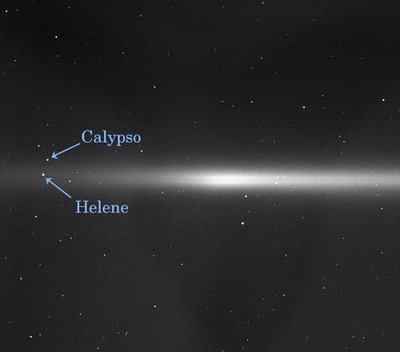Tuesday, April 25, 2006
Saturn's E Ring
Enceladus, moon of Saturn, has active geysers pounding ice particles into Saturn orbit from reservoirs just under the surface. They form the E Ring, captured here in an image with two of Saturn's smaller moons.
 You're seeing the ring edge-on in this image above. Notice the dark band in the middle? That's the plane of the Saturn system, otherwise described as that imaginary flat surface directly over the planet's equator. Most of Saturn's inner moons and all of its rings orbit in the plane. Why might that dark band appear here? The Cassini web page describes it:
One possible explanation is that all the E ring particles come from the plume of icy material that is shooting due south out of the moon's pole. This means all of the particles are created with a certain velocity out of the ringplane, and then they orbit above and below that plane.
For the E Ring to have a pronounced "gap" would mean that Enceladus geysers have been at that moon's south pole for some time. If eruptions of ice were random across the surface (as Io's volcanoes are) the E Ring would be fuzzy (as it is) but without a dark band in the middle.
Of course, scientists must date the age of the E Ring. That will help them assess how long geysers have been spouting off on that little moon.
You're seeing the ring edge-on in this image above. Notice the dark band in the middle? That's the plane of the Saturn system, otherwise described as that imaginary flat surface directly over the planet's equator. Most of Saturn's inner moons and all of its rings orbit in the plane. Why might that dark band appear here? The Cassini web page describes it:
One possible explanation is that all the E ring particles come from the plume of icy material that is shooting due south out of the moon's pole. This means all of the particles are created with a certain velocity out of the ringplane, and then they orbit above and below that plane.
For the E Ring to have a pronounced "gap" would mean that Enceladus geysers have been at that moon's south pole for some time. If eruptions of ice were random across the surface (as Io's volcanoes are) the E Ring would be fuzzy (as it is) but without a dark band in the middle.
Of course, scientists must date the age of the E Ring. That will help them assess how long geysers have been spouting off on that little moon.